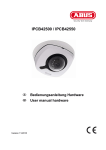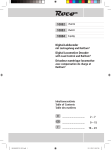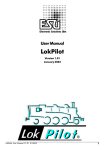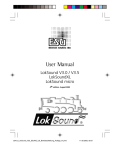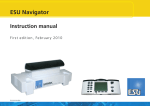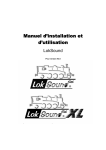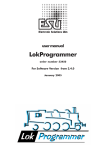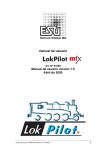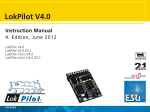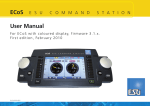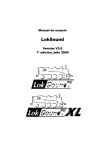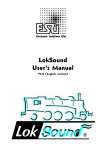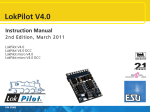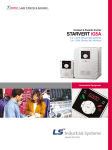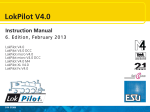Download LokSound
Transcript
user manual LokSound Art.No. 624xx user manualVersion 1.0 April 2005 user manual LokSound mfx / 1. Auflage, 04/2005 1 Inhaltsverzeichnis 1. Introduction 2. Characteristics of LokSound mfx decoders 3. Installation of LokSound decoders 3.1 Installation requirements 3.2 Engines with DCC interface 3.2 Loks mit NEM-Schnittstelle 3.3 Engines without interface 3.3.1 Connecting DC motors 3.4 Connecting the speaker 3.5 Connecting auxiliary function devices 3.6 Connecting a wheel sensor 4. Set up of the decoder 4.1 Analogue operation with Märklin® -Transformer 4.2 Digital operation 4.2.1 Using Märklin® 6021 4.2.2 Using mfx-Systems 5. Adjusting decoder parameters 5.1 Adjustable decoder parameters using Märklin® mobile station 5.2 Adjustable decoder parameters when using Märklin® control unit 6020 or 6021 5.2.1 Available parameters when using 6021 5.2.1.1 Resetting to default values (factory pre-sets) 5.2.1.2 Load control 5.2.1.3 Sound adaptation 5.2.1.4 Second Märklin® address 5.2.1.5 Settings for analogue mode 5.2.2 Adjusting values using Märklin® 6021 5.3 Decoder parameters that can be set with the Märklin® central station 5.4 Adjusting decoder parameters using the ESU LokProgrammer 53451 6. Frequently asked questions (FAQ) 7. List of CV’s for control unit 6021 8. Service, support and assistance 3 4 5 5 5 6 7 7 8 8 8 9 9 9 9 9 10 10 10 10 10 11 12 12 12 13 13 13 14 14 Copyright 2004 by ESU electronic solutions ulm GmbH & Co KG. Irrtum, Änderungen die dem technischen Fortschritt dienen, Liefermöglichkeiten und alle sonstigen Rechte vorbehalten. Elektrische und mechanische Maßangaben sowie Abbildungen ohne Gewähr. Jede Haftung für Schäden und Folgeschäden durch nicht bestimmungsgemäßen Gebrauch, Nichtbeachtung dieser Anleitung, eigenmächtige Umbauten u.ä. ist ausgeschlossen. Nicht geeignet für Kinder unter 3 Jahren wegen verschluckbarer Kleinteile. Bei unsachgemäßem Gebrauch besteht Verletzungsgefahr durch funktionsbedingte Kanten und Spitzen. Märklin ist ein eingetragenes Warenzeichen der Firma Gebr. Märklin und Cie. GmbH, Göppingen. ESU electronic solutions ulm GmbH & Co. KG entwickelt entsprechend seiner Politik die Produkte ständig weiter. ESU behält sich deshalb das Recht vor, ohne vorherige Ankündigung an jedem der in der Dokumentation beschriebenen Produkte Änderungen und Verbesserungen vorzunehmen. 2 user manual LokSound mfx / 1. Auflage, 04/2005 Introduction 1. Introduction Congratulations on purchasing a LokSound mfx decoder! With LokSound mfx your engines sound like the prototype. You will soon notice that your LokSound mfx equipped engines are the centre of attraction on any layout. Of course, you would like to install this decoder immediately, but first we have a request: Please read this manual carefully prior to installation!!! Although LokSound mfx decoders are very robust, incorrect wiring may destroy the module! Due to its factory settings your new LokSound mfx decoder can generally be used as is. In addition it offers a multitude of options to help you adjust your LokSound mfx decoder even better to your model. Please familiarize yourself with the decoder before installing it and adjusting any parameters. Also note the recommendations regarding installation. Important warning: • LokSound decoders are designed for use in model railways only • Avoid mechanical force or pressure on the decoder • Do not expose to wet and humid conditions • Do not remove the heat shrink sleeve on the decoder • Never solder on the circuit board, extend cables if necessary • Never wrap the decoder in insulation tape, since this may prevent heat dissipation and cause overheating • Always disconnect the circuit when installing the decoder • Make sure that neither the LokSound decoder nor any blank wire ends may come into contact with the engine chassis (risk of short circuit). Cover any blank ends of unused wires. • Make sure that no wires are squeezed or cut by the model’s transmission parts when reassembling the engine. • Take care when reassembling the engine that no wires are squeezed or a short circuit could occur. user manual LokSound mfx / 1. Auflage, 04/2005 Handle speakers with extreme care: Do not touch the membrane or apply pressure! Solder speaker connections quickly and only at the intended contacts! Pay close attention to the instructions for installing the speaker! If you adhere to these warnings your LokSound mfx decoder will reward you with long life and troublefree operation. ESU GmbH & Co. KG, November 2004 This manual has several chapters explaining step by step how to proceed: Chapter 2 provides an overview of the characteristics of LokSound mfx decoders. Chapter 3 describes installation and connection of LokSound mfx decoders. LokSound mfx decoders are suitable for most digital command control systems that either work with the Märklin Motorola data format (e.g. control unit 6020, 6021) or the new mfx-data format (e.g. mobile station or central station). Of course LokSound mfx decoders can also be used on conventional AC layouts. Chapter 4 provides an overview on which digital and analogue systems may be used to operate LokSound decoders as well as some particularities with certain systems. If you want to modify the preset running characteristics and/or sound effects we strongly recommend reading Chapter 5. Here you will gain an insight regarding the many options and how to adjust various parameters of the LokSound mfx decoder with different systems. You will also learn how to reset the decoder to the factory settings. Depending on the type of central unit not all functions may be available. For easy setting of parameters we recommend either the Märklin central station or the ESU LokProgrammer (Art. No. 53450). Both systems offer a graphic display, which makes setting any parameter of your LokSound decoder a simple task. In the following Chapter 6 we comment on frequently asked questions in greater detail. In Chapter 7 a table provides all you need to know regarding the programming of decoder characteristics as outlined in chapter 5. 3 Characteristics of LokSound mfx decoders 2. Characteristics of LokSound mfx decoders The LokSound mfx decoder is a universal electronic module for installation in model engines preferably in HO gauge AC models. The LokSound mfx revolutionizes authentic model train operations: It intelligently combines a sophisticated digital decoder and a digital sound module. With LokSound mfx you can run your engine with load control and many auxiliary functions while enjoying the original sound of the prototype. Its unique features provide flexibility and reliability in operation that you have come to expect from a state-of-the-art decoder. Even future standards are no problem for LokSound: its flash technology allows adaptation to the latest developments. All you need for updating is the LokProgrammer 53450. Multi-protocol operation: The LokSound mfx decoder was specially developed for models with a centre pickup (3-rail operation). Trouble-free operation with all Märklin® / Motorola® – central units was the main design objective. Furthermore 100% compatibility with Märklin® systems and its data format mfx was paramount thus providing maximum user comfort with mfx. Fully automatic change between all 3 operating modes „on-the-fly“ (AC analogue, mfx digital, Motorola® digital) Motor types: the following motor types may be connected to LokSound mfx: • DC motors (e.g. Bühler, Mabuchi) • Coreless motors (e.g. Faulhaber, Maxxon) • Universal motors with HAMO-conversion (thus converting the universal motor to a DC motor) High motor tact frequency: due to the tact frequency of 32 kHz (!) the motor is operated in the best possible way. Therefore the motor not only runs silent (no singing or humming), there will be less heat and also longer life. LokSound mfx decoders are particularly suitable for coreless motors. Motor control: the LokSound mfx has load control of the 4th generation: you can adapt it to your motor or turn it off. Thus your engine will travel at a constant speed regardless of the load or if the engine travels up or down a gradient. Motor control is pre-set for operation with Märklin® 6090x high performance drives resp. universal motors with HAMO-conversion. 4 Function outputs: Besides the two lighting outputs there are two more auxiliary function outputs available: Turn on the smoke generator or the interior lights remotely or un-couple by the push of a button on 4 your central unit! Lighting effects and individually dimmable lamps provide never before experienced fun when „playing“ with your trains and absolutely realistic models. Brake sections: LokSound mfx decoder understand (and respond to) the Märklin®-brake section. Protection: both the motor output and the function outputs are protected against short circuit as far as possible. Please take care that the maximum permitted current for the function outputs may not be exceeded under any circumstances. Also prevent short circuits across the outputs: although the LokSound mfx has protective circuitry it is subject to damage or destruction if an external power is supplied to the output terminals. Analogue mode: LokSound mfx decoders can be operated on AC layouts without any problems. Easy adaptation: Even with the Märklin® 6021 you can adjust most parameters comfortably without opening the locomotive. It is even easier with mfxcentral units or with the ESU LokProgrammer. • A digital, four-tone sound module with unique features: Prototype sounds: sounds of prototype engines were sampled using high fidelity microphones and recorded digitally on the flash memory module. Thus your engines sound exactly like the prototype! With four independent channels your engine sounds even more realistic since you can simultaneously add 3 sound effects to the running sound. Pumps, power switches and squealing brakes are all heard at the same time. LokSound mfx allows you to hear the exhaust chuffs of steam engines as they vary with the revs of the drivers and the load. Now you can really hear your engine work. Diesel engines can now simulate the reduced revs of the diesel while the engine is coasting. The running sound and the sound of the fans (blowers) in electric engines are now separate. Pressing a function button triggers additional sound effects. On mfx capable controllers the matching symbol is displayed at the same time. Random sounds: sound effects such as air pump, water pump, fire man Fred, discharging compressed air, etc. are randomly triggered. user manual LokSound mfx / 1. Auflage, 04/2005 Installation of LokSound decoders 3. Installation of LokSound decoders 3.1 Installation requirements The engine must be in good mechanical condition: only an engine running smoothly in analogue mode should be modified for digital operation. An engine running poorly in analogue mode will not operate satisfactorily in digital mode – even with the best digital decoder. Check and clean or replace any wear and tear parts such as motor brushes, wheel contacts, lamps etc. Always remove the engine from the track when doing maintenance work or modifications. Make sure that no voltage is applied – intentionally or accidentally – while you work on the model. LokSound mfx decoders have a certain size: make sure, that the decoder fits easily into the engine, that no pressure is applied when replacing the housing onto the chassis and that no wires are squeezed between other parts. Further, make certain that no wires obstruct any moving parts such as transmissions and. Never pack a LokSound decoder in foam pads etc. The decoder heats up during operation; good heat dissipation is essential. Electronic components are sensitive to electrostatic charges: always make sure that your work place is grounded. If necessary, use an earthed wristband. Stift 1 2 3 4 5 6 7 Description motor connections right back up light function F1 track connection 1 motor connections light front common (+pole ) colour Orange yellow green black grey withe blue 1=orange 5=grey fig. 1: Interface as per NEM650/652 • Remove the body! Follow the instructions in the manual of the engine! • Remove the analogue plug or directional relay. Please keep the plug / relay for future use. • Insert the decoder plug with pin 1 (the side with the red/orange wire) into the side of the socket that is usually marked with *, +, . or 1. Take care not to bend any pins. Do not rely on the assumption that the wires have to lead in a certain direction; the marking is the only valid reference. • Place the decoder in a suitable location within the engine and fasten it with double sided tape or a drop of hot glue. • Now fix the speaker in a suitable place. See chapter 3.4 When installing the decoder make sure that no metal part of the chassis touches any components of the decoder. 3.2 Engines with DCC interface 3.2 Loks mit NEM-Schnittstelle LokSound mfx is supplied with an 8-pin plug as per NEM 650/652 (NMRA S9.1/9.2) as shown in figure 1. Therefore installation in engines with NEM socket is particularly easy: user manual LokSound mfx / 1. Auflage, 04/2005 5 Installation of LokSound decoders speaker 100Ω violett green yellow withe AUX 2 AUX 1 light back light front 2 x dark brown LokSound mfx blau black red orange grey engine fig. 2: Wiring of LokSound with isolated funktions speaker 100Ω violett AUX 2 green yellow withe AUX 1 light back light front 2 x dark brown LokSound mfx Lokgehäuse orange black red grey engine fig. 3: Wiring of LokSound with common pole connected to the chassis 3.3 Engines without interface Unfortunately not every engine has a digital interface and thus the wiring becomes more elaborate: First disconnect any existing wires within the engine and any connection to the chassis. Both motor contacts must be isolated, make sure there isn’t any connection to the chassis, the wheels or the pantographs. This may easily be overlooked particularly in Fleischmann models! 6 After installing the decoder please check all connections with an Ohmmeter and look out for any short circuits between motor- and current pick-ups. How to proceed depends on how the headlights and other functions are wired in the engine: a) If headlights and functions are isolated from the engine chassis (free of any voltage) proceed as per figure 2. b) Headlights and functions are connected with their common to the track voltage (e.g. almost all Märklin® -engines and older Fleischmann or ROCO engines) as per figure 3. user manual LokSound mfx / 1. Auflage, 04/2005 Connecting DC motors remove capacitor! Don’t get confused by the fact that both figure 2 and 3 show how to wire DC - and coreless motors. How to wire a universal motor (Märklin®) is shown in figure 5. • Connect the red wire to the right rail pick-up (or centre pick-up in AC models), the black wire to the left rail pick-up (common rails in AC models). • Connect the backup lights to the yellow wire, the headlights to the white wire. • Connect the green wire to the function output AUX-1 and the purple wire to the function output AUX-2. Allocate the function buttons later. • Connect the speaker to the two dark-brown wires. • If the headlights and functions are isolated from the chassis (see figure 2) connect all commons to the blue wire. Make sure the blue wire has no contact to the engine chassis! 3.3.1 Connecting DC motors • Connect the orange wire with the motor terminal, which was originally wired to the right wheel pickup (centre pick-up in AC models). • The grey wire goes to the terminal, which was originally connected to the left wheel pick-up (common rails for AC models). • Exchanging wires causes a change of direction. • Some engines with the Märklin® 5-pole high performance drive may have 3 RFI suppressors soldered to the motor shield. The two suppressors that connect the motor terminals with the motor chassis must be removed (see figure 4). Any chokes have to remain in the locomotive for radio frequency transmission suppression. user manual LokSound mfx / 1. Auflage, 04/2005 orange grey fig. 4: 5 pol. Märklin® high performace drive 3.4 Connecting the speaker LokSound mfx decoders may only be used with the speakers supplied by ESU electronic solutions ulm GmbH & Co. KG. They have an impedance of 100 Ohm. The use of speakers by others may cause considerable distortion and in extreme cases even destroy the LokSound decoder. The correct position of the speaker is crucial to achieve high quality sound. A speaker that is installed without a resonance chamber will not generate good sound. Therefore carefully select the location and baffle for the speaker. The speaker must be installed in such a way that the sound waves are not unduly blocked. Please handle speakers with extreme care: don’t apply pressure or touch the membrane! The speaker’s magnets are very powerful! Keep all metal items away and secure the speaker firmly when soldering. The soldering iron may pull the speaker due the magnetic field and destroy it. Connect the speaker to the 2 dark brown wires of the LokSound mfx module. Make sure that you use a small soldering iron (max. 20 W) and only heat the marked spots as shown in the figure (close to the edge of the small contact plate). Polarity is not important. s o l d e r here! 7 Connecting auxiliary function devices speaker sound chamber An optimal sound effect is achieved by putting the speaker into a baffle, which is supplied with the speaker. This will increase the sound pressure and channel the sound in one direction. Without baffle the sound effect may be unsatisfactory. Feed the speaker wires through a small hole in the baffle. A suitable baffle is supplied with each speaker. The speaker should be fitted tightly into the baffle. 3.5 Connecting auxiliary function devices Any load may be connected to the lighting and auxiliary function outputs as long as it doesn’t exceed the maximum current (see technical data in the appendix of this manual). Note that the overload protection of the decoder reacts quickly and will switch off all functions immediately in case of an overload or short circuit. Therefore use only lamps for 16 V (or a higher voltage) and a maximum nominal current of 50 mA: incandescent lamps have a high starting current and may trigger the overload protection during switch-on. Use only digital smoke generators (e.g. Seuthe No. 11) for engines whose lighting and auxiliary function outputs are connected as shown in figure 2. Other smoke generators draw too much current. There are smoke generators with more than 250 mA nominal current on the market! Engines that are wired as shown in figure 3 require an analogue smoke generator e.g. Seuthe No. 10. Make sure that the total current for the function outputs does not exceed the permitted current rating and avoid short circuits between outputs. Although the output circuits of the LokSound mfx are protected, a high voltage on the terminals or a short circuit may cause damage! 8 3.6 Connecting a wheel sensor To synchronize the exhaust chuffs with the revs of the drivers an external sensor can but does not have to be used. The sensor input is described in figure 5. The LokSound mfx decoder supports reed contacts or mechanical contacts. If you want to use a reed contact on miniature magnet (available in hobby shops) for each exhaust chuff has to be fixed on the driver axle. Thus each magnet triggers the reed contact once per turn. The best choice is miniature reed contacts available in electronic stores. Suitable magnets are available in model train stores (e.g. Mini track magnets). They may have to be adapted using a file. Generally speaking all 2-pole mechanical contacts can be used as long as both poles are fully isolated (no connection to the chassis). The sensor has to be activated (software) before it actually will work. Refer to chapter 5.2.1.3 LokSound driving axle Miniature Reed switch magnet Abb. 5: Connecting a wheel sensor 4. Set up of the decoder After successful installation you may now operate the LokSound mfx decoder. The following will outline how you can check if you have installed the decoder correctly. Chapter 4.1 describes analogue operation. In chapter 4.2 you learn how to operate LokSound mfx with various digital systems. Before changing any decoder settings (e.g. engine address, sound volume) we recommend to read chapter 5. There you find out which parameters are available with LokSound mfx decoders and how they may be adjusted with the DCC command stations supported by mfx decoders. user manual LokSound mfx / 1. Auflage, 04/2005 Analogue operation with Märklin® -Transformer 4.2 Digital operation Please check all connections carefully using an Ohmmeter: Are there any short circuits between the motor terminals and the wheel pick-ups? Are all connections between motor terminals and the chassis isolated? Are lamps connected properly and isolated from the chassis? Is the decoder installed safely to avoid contact with the chassis? Is there sufficient space around the LokSound decoder to allow for heat dissipation? Could the LokSound decoder or any of the wires be squeezed when refitting the housing? Is the speaker installed in such a way that sound can emit from the engine without obstruction? After all the above points have been checked you may apply power to the engine. We strongly recommend carrying out this initial test on a track section with over-current protection. The ESU LokProgrammer 53450 has an integral current guard. The factory pre-set address Motorola®-mode is 03 for the 4.2.1 Using Märklin® 6021 Operation of class BR 86 is possible with all previously marketed Märklin® control devices such as delta control, control unit 6020, control unit 6021 or compatible systems. The functions F1 to F4, however, can only be activated with the „new Motorola® format“. To activate this format put DIP-switch 2 of the 6021 to the upper („On“) position. The LokSound mfx decoder offers a special feature: besides „the normal“ address (factory pre-set: 03) the decoder also „understands’ the following address (factory pre-set: 04). Whenever you call up this address with your central unit you can activate functions F5 to F8 with function buttons F1 to F4. Thus, even when using central unit 6021 8 functions plus headlights are available. Since this feature requires another address of the total of 80 addresses it can be turned off if not required. Please refer to chapter 5.2.1.4 Subject to the prototype engine the function buttons are assigned to different sound effects. A list of the respective functions is available on our website. 4.2.2 Using mfx-Systems The engine reports automatically to all mfx-central units. Does the engine move in both directions? Turn the lights on: are they operating correctly? If the LokSound mfx decoder was built into an engine with NEM / DCC interface: check if the plug has been inserted correctly. The LokSound mfx decoder can be operated with any central unit compatible with Märklin® systems and mfx data format. Once you have placed the engine on the track it will automatically register with the command station and is ready for operation. The appropriate symbols are already assigned to the function buttons. Operation can begin immediately. 5. Adjusting decoder parameters 4.1 Analogue operation with Märklin® Transformer Operation with conventional Märklin® AC controllers works as you know it from other models: turning the knob controls speed. To change direction the knob has to be turned to the left beyond the stop position. Please note the following: The engine must have completely stopped before changing direction. Never change direction while the engine is moving! user manual LokSound mfx / 1. Auflage, 04/2005 Chapter 5 provides information on how to change the settings of LokSound mfx decoders. Please take your time to read and understand the somewhat complex explanations. The number of the available functions and how to adjust them varies considerably subject to the type of central unit. The easiest way to set parameters is by means of a PC and the ESU LokProgrammer 53450. Using the Märklin® central station makes this process just as simple. Regardless of which system was used for programming the decoder all modifications to the parameters will be implemented even when using a different type of central unit. Thus could for instance change some parameters with the control unit 6021 and use a mobile station for running your layout. Or you could set all parameters with the ESU LokProgrammer, and subsequently run your trains with a control unit 6021. 9 Adjustable decoder parameters 5.1 Adjustable decoder parameters using Märklin® mobile station The Märklin® mobile station is designed as a beginners device and focuses on the most important control elements. LokSound mfx decoders can be operated with a mobile station without any problems and you can enjoy the advantages of mfx: • 128 speed steps • Automatic registration of engine • Display of name of engine • Display of the first 8 functions (plus headlights) corresponding to the selected type of sound • Display of suitable symbol for the engine Please note that the LokSound mfx offers far more parameters. Within this chapter we only show you which parameters can be activated with 6021. Please note that wrongly set CVs can impair the functionality of the decoder. Theoretically you can enter values from 01 to 80 in each CV. Depending on the value stored in a CV the behaviour of the decoder will vary. When looking at the table in chapter 7.1 you will notice that most CVs contain simple numerical values. For instance CV 01 contains the address in Motorola®mode. It can vary from 01 – 80 (refer to the range of values). The factory pre-set is 03. The mobile station allows you to call up a total of 9 functions. 5.2.1.1 Resetting to default values (factory pre-sets) While the mobile station is ideally suited for running trains, it is only possible to adjust the following parameters of the LokSound mfx decoder: • Name of engine You can reset the decoder to the default values at any time. Simply write the value 08 in CV 08. A reset of sound files can only be done with the LokProgrammer 53450. • Maximum speed 5.2.1.2 Load control • Acceleration The LokSound mfx decoder has 4th generation load control assuring that the engine always runs at the predetermined speed regardless of the actual load. Load control was optimised and tested with: • Deceleration • Sound volume of the decoder For setting all remaining parameters the mobile station is not suitable. # • Märklin® • ROCO, 5.2 Adjustable decoder parameters when using Märklin® control unit 6020 or 6021 Prior to the introduction of the Märklin® central station the control unit 6020 and its successor 6021 represented the fully-fledged digital command stations by Märklin®. With the 6020 resp. 6021 the most important parameters of the LokSound mfx decoder can be adjusted. First we will explain which parameters can be set with these central units; in chapter 5.2.2 will describe how to do it. • Bachmann (Liliput), • BRAWA, • Bühler, If so desired you can deactivate load control. Influence of load control You can adjust the effect of load control with CV 56: If you want to deactivate load control for instance, then enter the value 0. Value 63 represents 100% load compensation. 5.2.1 Available parameters when using 6021 The control unit 6021 resp. its predecessor 6020 have a two-digit display and permit you to enter numbers from 01 to 80. Therefore LokSound mfx organises access to the internal configuration parameters in such a way that they suit these limitations. The available configuration parameters are organised in so-called CVs (Configuration Variables). 10 user manual LokSound mfx / 1. Auflage, 04/2005 Parameters of load control Parameters of load control The internal PI-control algorithm depends on three parameters: in CV 53 the reference voltage is set while in CVs 54 and 55 the control components of the PIcontrol are set. Reference voltage: In CV 53 you set the Back EMF voltage that should be supplied by the motor. This value depends on the track voltage and the coefficient of utilization of the motor. A coefficient of 75 % and a track voltage of 16 Volts adds up to a voltage of 16 V * 75 % = 12 Volts. That value has to be written into CV 53. The voltage (here: 12 V) may be entered in 0.4V-increments. This results in a value of 30 (12V * 0.4) for CV 53. If you don’t know the exact motor coefficient you may obtain the value experimentally as follows: Read out the value in CV 53 as described above. Leave the value of CV 55 („I“) for the time being and test-run the engine. Now change the value of CV 54 in steps of 5 downwards or upwards and observe the running properties of the engine. If there is no improvement leave the value of CV 54 and change the value of CV 55 (intensity of control) in steps of 5 until an optimum is reached. Please note that incorrectly set parameters may impede the effect of Back EMF control to the point that the motor may stop altogether. Refer to our website http://www.loksound.de for suggested values for commonly used motor / drive combinations such as: Parameters for Fleischmann motors Engines with the traditional Fleischmann motor should be programmed as follows: CV 54 = 60 Check, if the engine really reaches top speed at the highest speed step or if you cannot detect any speed changes at the top speed steps. In the latter case you have to reduce the value in CV 53, in the first case increase the value. The internal PI-regulation of LokSound mfx can be adjusted with CV 54 and CV 55. Depending on the type of motor the parameters may have to be adjusted to achieve optimal running performance. LokSound mfx decoders are optimised ex works for use with Märklin®-motors. Parameter ‘K“, stored in CV 54, influences how strongly load control will effect the driving performance. The higher the value, the more load control will respond to any changes. Adjust this value with care, because too high values could lead to irregular and „hard“ driving performance. If you prefer smooth running try to reduce the value step by step until you reach an optimum. Parameter „I“, stored in CV 55 provides important information to the LokSound mfx decoder regarding the motor type used: certain electric motors respond differently to adjustments of the rpm’s. The longer a motor takes to respond the lower the value in CV 55. However, it is not easy to recognize the degree of inertia. In general: a motor with a larger diameter and more poles and/or flywheels - the more inertia it has – should have a lower value in CV 55. For optimal programming proceed as follows: user manual LokSound mfx / 1. Auflage, 04/2005 CV 55 = 20 5.2.1.3 Sound adaptation LokSound decoders offer many possibilities to adjust sound effects. All parameters are stored in CVs that, like all others, may be modified. Adaptation of revolutions for diesel and pitch for steam exhaust chuffs. The revolutions of a diesel motor may be modified with 2 CVs: Enter the revolutions of the idling diesel motor in CV 59. The standard value of 32 permits reproduction of the sound at original speed, while value 16 reduces this to half speed. Enter the revolutions at maximum speed (respectively maximum revs) in CV 60: Value 64 means double the original speed. Use the same parameters when adapting the pitch of the exhaust chuffs for steam engines: The interval of the exhaust chuffs should not only be shorter but also vary in pitch with increasing speed. Specific settings for steam engines To simulate a steam engine you have to synchronize the exhaust chuffs with the revolutions of the drivers. LokSound mfx offers 2 ways to achieve this: • An external wheel sensor • Speed step dependent 11 Second Märklin® address Depending on the method selected, certain CVs have to be set accordingly. LokSound mfx is factory preset to speed step dependent adjustment. Using a wheel sensor The wheel sensor must be connected as described in chapter 3.6. Then two more parameters have to be set: Set CV 57 to value 01 and enter a value > =01 in CV 58. CV 58 defines after how many pulses by the sensor the next exhaust chuff is reproduced. Normally one exhaust chuff per pulse should be played. 5.2.1.4 Second Märklin® address In order to be able to use functions F5 to F8 with the Märklin® control unit 6021 LokSound mfx decoders have a second Märklin address. It is always the following number to the actual address. This address has to be entered in CV 75. Should you not require this feature please enter the first Motorola® address in CV 75 (the same as in CV 01), in other words CV 01=CV 75. Even though the second Motorola®-address is independent of the first one we recommend always to select the base address in CV 01 + 1 as the second address. Speed step dependent control With this method the interval between exhaust chuffs is determined with CV 57 and CV 58. This method is recommended if an external wheel sensor cannot be used. The adaptation of this variable to the wheel / gearbox combination may require some experiments. It pays to spend some time in order to achieve an optimal result. This feature works best with Back EMF control set to 100%. For adjusting the CVs you should proceed as follows: • Set CV 57 to 10 and CV 58 to 26. • Put the engine onto the track and drive it with speed step 1 (sound is switched on). • Measure the time in seconds it takes the driver to complete one turn at this speed. • Divide the time by 0,064. • Enter a rounded value without decimal points in CV 57, e.g. 0.9 seconds / 0.064 = 14-5= value 9. • Increase the speed and check whether the exhaust chuffs match the turns of the drivers. If the exhaust chuffs are too fast, increase the value in CV 58 gradually, if they are too slow, decrease the value in CV 58. Adjusting the volume The volume of LokSound mfx decoders may be adapted gradually. Enter the desired value in CV 63. Permitted values are: 1 (quiet) to 63 (loud). 5.2.1.5 Settings for analogue mode You can set the starting speed in analogue mode by adjusting CV 78: the higher the value the higher the speed of the engine. The maximum speed can be adjusted by reducing the value in CV 79: If your engine runs too fast in analogue mode simply reduce the value in CV 79. In analogue mode the decoder automatically deactivates load control. 5.2.2 Adjusting values using Märklin® 6021 For adjusting CVs with control unit 6020 or 6021 proceed as follows: Set the drive control knob to 0. Remove any other engines from the track. Observe the blinking signals of the engine! Press the „stop“- and „go“ button of the 6021 simultaneously until a reset has been triggered. Alternately you can press the „stop“ button in order to switch off the track voltage. Enter the current decoder address (alternately: „80“). • Confirm by activating change of direction (turning the control knob beyond the stop position towards the left) and hold the knob, then press the „Go“ button. • The LokSound mfx decoder is now in programming mode (headlights are blinking). Now enter the number of the parameter (CV) you want to change (two digit number). • Confirm by activating change of direction (double blinking headlights). • Enter the new value for the CV (2 digits). • Confirm by activating change of direction (headlights light up for about 1 second, then continue blinking). 12 user manual LokSound mfx / 1. Auflage, 04/2005 Decoder parameters • Now you can continue with other CVs in the same manner. 5.4 Adjusting decoder parameters using the ESU LokProgrammer 53451 • To exit the programming mode select CV 80 or switch off the track voltage for a moment (press „stop“ button followed by „go“ button on 6021). Please note that 6021 only permits entries from 01 to 80. There is no value „0“, instead always enter „80“. The LokProgrammer available from ESU electronic solutions ulm GmbH & Co. KG offers the easiest method to adjust CVs of LokSound mfx decoders: 5.3 Decoder parameters that can be set with the Märklin® central station Using the Märklin® central station you can not only enter the parameters described above but also the following: • Change the name of the engine • Freely selectable speed curve • Assignment of function buttons (function mapping): you determine, which button has to respond in which manner and which symbol is to be displayed. • Assigning lighting effects to the individual function outputs: The LokSound mfx decoder offer a large choice of lighting effects such as dimmer, flash, Blinking or the simulation of the firebox. You determine which output is set to which effect and how bright the lamps should be. • Selecting and setting brake sections • Setting the maximum speed in analogue mode • Several other parameters The available options and how to set parameters is described in the Manual of the central station. It is done with a mouse click on your MS-Windows® computer. The PC saves you searching for various CV numbers and values. With the LokProgrammer you can access all parameters of LokSound mfx decoders. With the LokProgrammer you can also modify the sounds of LokSound mfx decoders and you may also create your own sound effects. You can also compile you own sound files. You may purchase the LokProgrammer (article no. 53450) at model train outlets complete with detailed operating instructions. The LokProgrammer part no. 50450 is not suitable for programming LokSound mfx decoders. 6. Frequently asked questions (FAQ) Usually there is no fault in the LokSound mfx decoder if it does not work as desired but very likely some CVs are set incorrectly. Here are some examples of what may happen and how to solve them: • Headlights and sound work, write CVs as well, but the engine does not move. A short circuit on the motor terminals or a high current draw may trigger the overload protection of the LokSound mfx decoder. Perhaps the motor is not fully insulated against the chassis. To eliminate this as the cause of the malfunction remove the motor and test-run it with your LokSound mfx decoder while outside the engine. • The engine jerks and runs very uneven at low speed with activated load control. Deactivate load control and check if the problem remains. If the problem disappears then the parameters for load control have to be adjusted. Try to adjust the parameters. • The engine runs perfectly, but there is no sound. Check the wires to the speaker. With the Märklin® 6021 the new Motorola format has to be used, otherwise the F1 button does not work. If the format is set correctly, the speaker may possibly be damaged. • I have read the instructions carefully but still have problems. What can I do? user manual LokSound mfx / 1. Auflage, 04/2005 13 Service, support and assistance Should you have further questions regarding LokSound mfx decoders you may contact our Technical Support. Contact details are listed in chapter 8 on the last page of this Manual. Should you have come to the conclusion you do not want to install decoders yourself we can offer you another solution: ESU electronic solutions ulm GmbH & Co. KG offers an installation service in conjunction with experienced specialists. 8. Service, support and assistance Your model train or hobby shop is your competent partner for all questions regarding LokSound decoders. You may also contact us directly. For enquiries please use either email or fax (don’t forget to provide your own fax-no.) and we will reply within a few days. Please call our hotline only in case of complex enquiries that can’t be dealt with by email or fax. The hotline is often very busy and you may encounter delays. Also check our website for more information. You will find many hints regarding FAQ and even feed back from other users. Ask your dealer for the new ESU service pack: We arrange for installation of your decoder: comfortable and without risk for you! 7. List of CV’s for control unit 6021 The following pages provide a table listing all CVs of LokSound mfx decoders that can be adjusted with the control unit 6021. Change CVs only if you have a clear understanding of the implications: Incorrect settings may lead to malfunctioning LokSound mfx decoders. Hotline.: By eMail: By Mail: +49 (0) 700 - 56576863 * ( 0 )700 - LOKSOUND tuesday and wednesday 10.00 am - 12.00 pm [email protected] ESU electronic solutions ulm GmbH & Co. KG -technischer SupportIndustriestrasse 5 D - 89081 Ulm Internet: www.loksound.de * 0,12 EUR / Minute 14 user manual LokSound mfx / 1. Auflage, 04/2005 to 7. List of all supported CVs CV Name Description Range Default value 01 Engine address Address of engine 01 - 80 02 Starting voltage determines the minimum speed 01 - 63 03 03 Acceleration This value multiplied by 0.25 is the time from stop to maximum speed 01 - 63 16 04 Deceleration This value multiplied by 0.25 is the time from maximum speed to stop 01 - 63 12 05 Maximum speed Maximum speed of engine 01 - 63 63 08 Factory reset Resets decoder to default values - 53 Load control parameter 1 Parameter 1 (control reference) 01 - 63 Determines the back EMF voltage that the motor should supply at maximum speed. The more efficient the motor, the higher this value may be. Reduce this value if the engine does not reach its designed maximum speed. 35 54 Load control parameter 2 Parameter 2 („K“-component) of the internal PI-controller. 01 - 63 Determines how strongly load control effects. The higher the value, the stronger the decoder controls the motor. 24 55 Load control Parameter 3 („I“-component) The momentum of the motor determines parameter 3. Motors with large flywheels or large diameter require a smaller value. 24 56 Load control influence Determines how strongly load control is active. 01 - 63 03 8 01 - 63 63 57 Sound mode 1 Multiplied by 0,64 is the time in seconds 01 - 63 for the interval between two exhaust chuffs at speed step 1 The value 01 indicates that the exhaust chuffs are triggered by a sensor. 10 58 Sound mode 2 This value determines how the interval between exhaust chuffs is reduced with rising speed steps. A larger value stands for a stronger, a lower value for a lesser reduction. If the exhaust chuffs are triggered by a wheel sensor This value specifies the number of trigger pulses Required to release one exhaust chuff. 01 - 63 58 59 Running sound Divided by 32 is the factor determining the minimum rpm’s of the running sound at the lowest speed step. Values < 2 are slower, values > 32 are faster than the original speed 01 - 63 32 60 Running sound Divided by 32 is the factor determining the maximum rpm’s of the running sound at the highest speed step. Values < 2 are slower, values > 32 are faster than the original speed 01 - 63 55 63 Sound volume Volume for running and auxiliary sounds 01 – 63 63 64 Brake sound threshold specifies when the decoder should start the squealing brake noises. The higher the value the sooner it begins. 01 –63 07 user manual LokSound mfx / 1. Auflage, 04/2005 15 List of all supported CVs CV Name Beschreibung 73 Storage options Determines which information is stored permanently 00 – 07 in the decoder. Value 00 stores no data Value 03 saves the current speed step & function buttons Value 07 saves the current speed step & function buttons and causes continuation of travel with the predetermined acceleration after a reset. 03 75 Märklin Address 2 Second Motorola-Address for accessing F5 to F8. 01 – 80 04 78 Starting voltage in analogue mode AC 01-63 25 79 Maximum speed in analogue mode AC 01-63 63 16 Bereich Werkswert user manual LokSound mfx / 1. Auflage, 04/2005

















